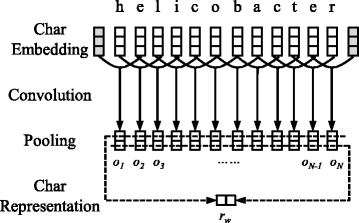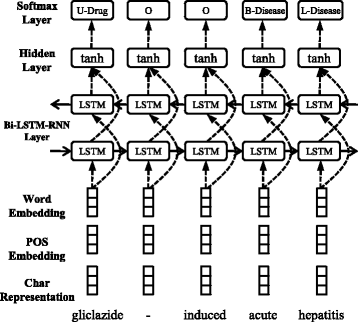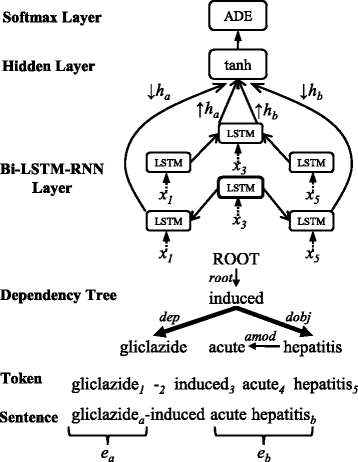A neural joint model for entity and relation extraction from biomedical text
- PMID: 28359255
- PMCID: PMC5374588
- DOI: 10.1186/s12859-017-1609-9
A neural joint model for entity and relation extraction from biomedical text
Abstract
Background: Extracting biomedical entities and their relations from text has important applications on biomedical research. Previous work primarily utilized feature-based pipeline models to process this task. Many efforts need to be made on feature engineering when feature-based models are employed. Moreover, pipeline models may suffer error propagation and are not able to utilize the interactions between subtasks. Therefore, we propose a neural joint model to extract biomedical entities as well as their relations simultaneously, and it can alleviate the problems above.
Results: Our model was evaluated on two tasks, i.e., the task of extracting adverse drug events between drug and disease entities, and the task of extracting resident relations between bacteria and location entities. Compared with the state-of-the-art systems in these tasks, our model improved the F1 scores of the first task by 5.1% in entity recognition and 8.0% in relation extraction, and that of the second task by 9.2% in relation extraction.
Conclusions: The proposed model achieves competitive performances with less work on feature engineering. We demonstrate that the model based on neural networks is effective for biomedical entity and relation extraction. In addition, parameter sharing is an alternative method for neural models to jointly process this task. Our work can facilitate the research on biomedical text mining.
Keywords: Biomedical text; Entity recognition; Joint model; Neural network; Relation extraction.
Figures



Similar articles
-
A neural network-based joint learning approach for biomedical entity and relation extraction from biomedical literature.J Biomed Inform. 2020 Mar;103:103384. doi: 10.1016/j.jbi.2020.103384. Epub 2020 Feb 4. J Biomed Inform. 2020. PMID: 32032717
-
JCBIE: a joint continual learning neural network for biomedical information extraction.BMC Bioinformatics. 2022 Dec 19;23(1):549. doi: 10.1186/s12859-022-05096-w. BMC Bioinformatics. 2022. PMID: 36536280 Free PMC article.
-
Extracting entities with attributes in clinical text via joint deep learning.J Am Med Inform Assoc. 2019 Dec 1;26(12):1584-1591. doi: 10.1093/jamia/ocz158. J Am Med Inform Assoc. 2019. PMID: 31550346 Free PMC article.
-
Enriching contextualized language model from knowledge graph for biomedical information extraction.Brief Bioinform. 2021 May 20;22(3):bbaa110. doi: 10.1093/bib/bbaa110. Brief Bioinform. 2021. PMID: 32591802 Review.
-
Neural network-based approaches for biomedical relation classification: A review.J Biomed Inform. 2019 Nov;99:103294. doi: 10.1016/j.jbi.2019.103294. Epub 2019 Sep 23. J Biomed Inform. 2019. PMID: 31557530 Review.
Cited by
-
OGER++: hybrid multi-type entity recognition.J Cheminform. 2019 Jan 21;11(1):7. doi: 10.1186/s13321-018-0326-3. J Cheminform. 2019. PMID: 30666476 Free PMC article.
-
Opportunities and obstacles for deep learning in biology and medicine.J R Soc Interface. 2018 Apr;15(141):20170387. doi: 10.1098/rsif.2017.0387. J R Soc Interface. 2018. PMID: 29618526 Free PMC article. Review.
-
Bio-semantic relation extraction with attention-based external knowledge reinforcement.BMC Bioinformatics. 2020 May 24;21(1):213. doi: 10.1186/s12859-020-3540-8. BMC Bioinformatics. 2020. PMID: 32448122 Free PMC article.
-
A Joint Extraction System Based on Conditional Layer Normalization for Health Monitoring.Sensors (Basel). 2023 May 16;23(10):4812. doi: 10.3390/s23104812. Sensors (Basel). 2023. PMID: 37430725 Free PMC article.
-
Spatial Relation Extraction from Radiology Reports using Syntax-Aware Word Representations.AMIA Jt Summits Transl Sci Proc. 2020 May 30;2020:116-125. eCollection 2020. AMIA Jt Summits Transl Sci Proc. 2020. PMID: 32477630 Free PMC article.
References
-
- Segura-Bedmar I, Martínez P, Herrero-Zazo M. Proceedings of the 7th International Workshop on Semantic Evaluation. Atlanta: Association for Computational Linguistics; 2013. Semeval-2013 task 9 : Extraction of drug-drug interactions from biomedical texts (ddiextraction 2013)
-
- Deléger L, Bossy R, Chaix E, Ba M, Ferré A, Bessières P, Nédellec C. Proceedings of the 4th BioNLP Shared Task Workshop. Berlin: Association for Computational Linguistics; 2016. Overview of the bacteria biotope task at bionlp shared task 2016.
MeSH terms
LinkOut - more resources
Full Text Sources
Other Literature Sources

